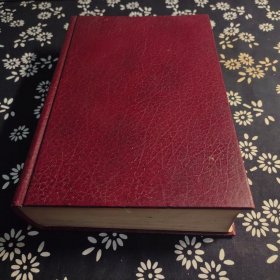
Encyclopedia of Eastern Europe: From the Congress of Vienna to the Fall of Communism(货号TJ)
¥ 1666 ¥ 350 九品
仅1件
作者Richard Frucht(ed.)
出版社Garland Publishing, Inc. / Routledge
ISBN9780815300922
出版时间2000
版次1
印刷时间2000
印次1
装帧精装
开本28.7*22.4
纸张胶版纸
页数972页
定价350元
货号TJ2443-I119
上书时间2024-01-30
- 在售商品 暂无
- 平均发货时间 4小时
- 好评率 暂无
- 最新上架
商品详情
- 品相描述:九品
- 商品描述
-
本书原定价350.00美元,净重2800克,馆藏自然旧。【图书分类:综合性图书 > 百科全书、类书 > 各国百科全书 > 东欧、中欧】First published in 2000. Routledge is an imprint of Taylor & Francis, an informa company.
From Library Journal:
Although the term Eastern Europe has not only been incorrectly used in the West"geographically, Eastern Europe includes the countries of Central and South Europe"it has also created many political stereotypes and has redefined the very definition of the West. Now, finally, someone has put together a much-needed encyclopedia that attempts to give an overview of the oppression, domination, unfair verdicts, and neglect imposed on these countries from within as well as from outside since the Congress of Vienna in 1814 to the fall of communism in 1989. With the help of countless well-informed contributors from academia, Frucht (history, Northwest Missouri State Univ.) has compiled an impressive number of entries that encompass all Communist countries of the East, excluding East Germany and the countries of the former Soviet Union, focusing not only on their political but also geographical, artistic, and cultural uniqueness. Much is omitted here for the simple reason that to have it all in one volume would be next to impossible, but the information provided is probably the most essential. A few inconsistencies aside (there is an entry for the Black Sea but there is no entry for the Adriatic Sea, which belongs not just to Italy but Croatia, Montenegro, and Albania as well), all entries are highly informative, clearly written, and accurate and the lists of further readings will make this a practical reference tool for both students and teachers. Although those who have long been aware of this region!s fascinating history will demand more in-depth coverage, this volume may, ironically, help the other Westerners begin to see it for its individuality. An indispensable purchase."Mirela Roncevic, Library Journal
From Booklist:
This volume aims to be an up-to-date source for the region, also known as East Central Europe, Central Europe, or Southeastern Europe, taking into account the profound changes that occurred after 1989 while providing the historical context of at least two centuries back to the Congress of Vienna.Why publish such a resource now, more than 10 years after the fall of Communism in this part of the world? Through discussions with various educators in the field, the editor discovered a need for a reference source that could provide current information on the region, was wide-ranging, and was accessible for students. Alphabetically arranged entries include many biographies as well as issues (Bessarabian question ), geographic entities, military events (Brusilov Offensive June-August 1916 ), literature, historical events, movements, etc. There are long articles on the history of the seven primary countries of the region: Albania, Bulgaria, Czechoslovakia, Hungary, Poland, Romania, and Yugoslavia. Separate articles cover a nation's geography, art, culture, language, literature, and emigres. All entries include a bibliography and see also references. An index provides specific access to terms and concepts not found in the headings or see also references, making access complete.Another resource, Encyclopedia of Conflicts, Disputes, and Flashpoints in Eastern Europe, Russia, and the Successor States, by Bogdan Szajkowski (Longman, 1993), is perhaps this volume's only competitor. Because of its recency, Encyclopedia of Eastern Europe would be the choice for libraries wanting to provide up-to-date, accessible information. Recommended to those public and academic libraries needing to fill a gap in their Eastern European reference sections. REVWR
Synopsis:
In 1989, to the surprise of many, the infamous Iron Curtain separating Western and Eastern Europe collapsed. In a matter of months, a world that had existed for four decades was overturned, and nations and people who had for centuries been dominated - and at times destroyed - by their more powerful neighbours to the east and west were detatched from the Russian sphere of influence and set on radically new economic and political path. Eastern Europe has re-emerged on the world scene in ways unimaginable during the Cold War, from the unexpected expansion of NATO into former Warsaw Pact nations to the painful attempts to build democracy and market economies in areas that, until the late 1980s, saw political totalitarianism and planned economies. More recently, the outburst of violence associated with the disintegration of the former Yugoslavia has been a reminder that Eastern Europe is still a volatile and unpredictable region of the world, one still capable of being driven by powerful emotions rooted in the distant past. This encyclopedia explores the history of this complex region over the last two centuries.
The cornerstone of the encyclopedia are the articles on countries and regions of Eastern Europe: Albania, Bulgaria, the Czech Republic, Hungary, Poland, Romania, Slovakia, and the countries that once made up Yugoslavia. Additional coverage of European Russia is also included. These articles are both detailed and concise, offering the reader a brief but comprehensive introduction into a country's history during the last two centuries-a crucial time when Europe was swept by wars and convulsive political change that shaped the present. Eastern European history is often written from an "outsider" perspective-that is, from the vantage point of the impact of the West or of Russia on this crossroads of Europe. Although the influence of its neighbors is a formative and defining aspect of Eastern European history, it is not the only one. This encyclopedia offers a variety of rich detail covering the intrinsic cultural, political, and social phenomena of the region. The book also covers not only the leading figures who shaped the region's political destiny, but also the major artists, writers, and other culturally significant individuals during the nineteenth and twentieth centuries.
Some of these figures are known in the West, while others will be new to the average reader. A unique community of more than 200 scholars of Eastern Europe from the United States, Canada, and Europe - each an expert in his or her field - has been assembled to create more than 1,000 entries. An extensive map program enriches the text and helps the reader place a topic in geographic context. Bibliographies at the end of entries direct the reader to accessible sources for further reading or research on Eastern European history.
Review:
"This excellent reference....belongs in all reference collections."
-"American Reference Books Annual, 2000
"Now, finally, someone has put together a much-needed encyclopedia....All entries are highly informative, clearly written, and accurate and the lists of further readings will make this a practical reference tool for both students and teachers....An indispensable purchase."
-"Library Journal (starred review), July 2000
..."the choice for libraries wanting to provide up-to-date, accessible information. Recommended to those public and academic libraries needing to fill a gap in their Eastern European reference sections."
-"Booklist/RBB, October 2000
"An excellent and well-organized resource covering nearly 200 years of the region's history and civilization....Highly recommended for public, college, and university libraries."
-"Choice, September 2000
"The real service the "Encyclopedia of Eastern European History provides its readers is to concentrate information about this neglected part of Europe into one handy volume."
-"Against the Grain, November 2000
About the Author:
Richard Frucht is professor of history at Northwest Missouri State University. He received his Ph.D. from Indiana University in 1980 and is the author of two books dealing with Eastern Europe. In the early 1990s he headed the public education project of the American Association for the Advancement of Slavic Studies, which worked with teachers to incorporate the study of Eastern Europe into the school curriculum.
-

【封面】
-

【封底】
-

【目录】
-

【内页】
-

【内页】
-

【内页】
相关推荐
-

ENCYCLOPEDIA OF
八五品上海
¥ 388.00
-

Encyclopedia of Space
八五品上海
¥ 80.80
-

ENCYCLOPEDIA OF DEATH
八五品东莞
¥ 75.10
-

Encyclopedia of Dinosaurs
九品衡水
¥ 129.00
-

ENCYCLOPEDIA of ECONOMICS
八五品苏州
¥ 100.00
-

Encyclopedia of Animals
八五品北京
¥ 100.00
-

Encyclopedia of Whisky
八品成都
¥ 120.00
-

Encyclopedia of Whisky
八品重庆
¥ 125.00
-

Encyclopedia of Homeopathy
九品淄博
¥ 50.00
-

Encyclopedia of China
八五品衡水
¥ 72.00
— 没有更多了 —















以下为对购买帮助不大的评价